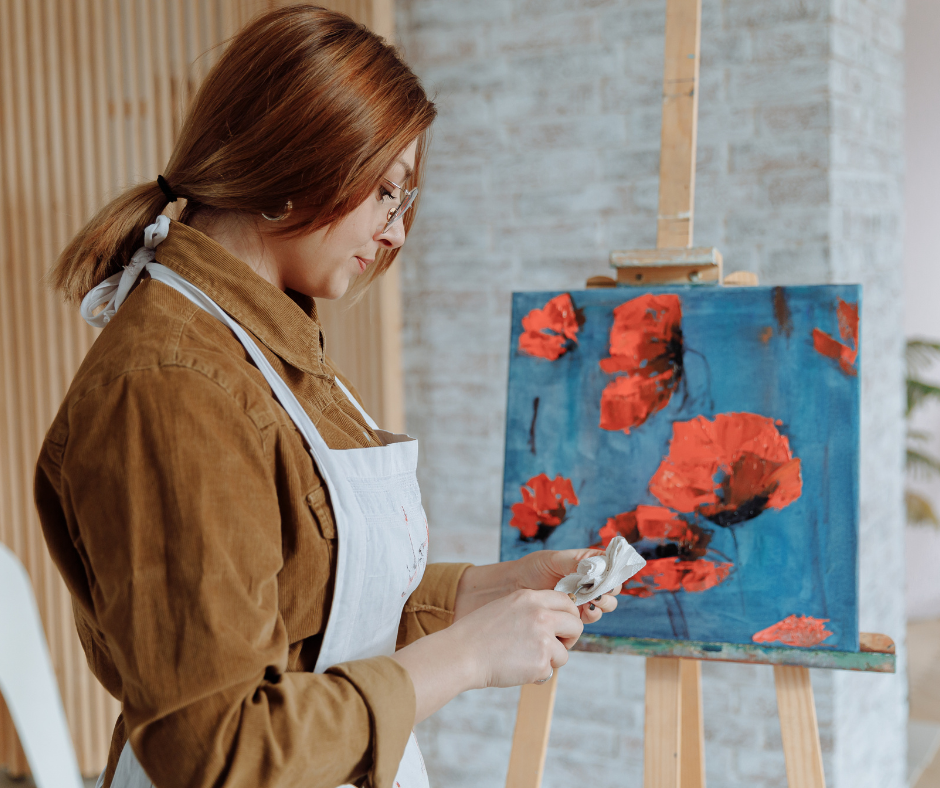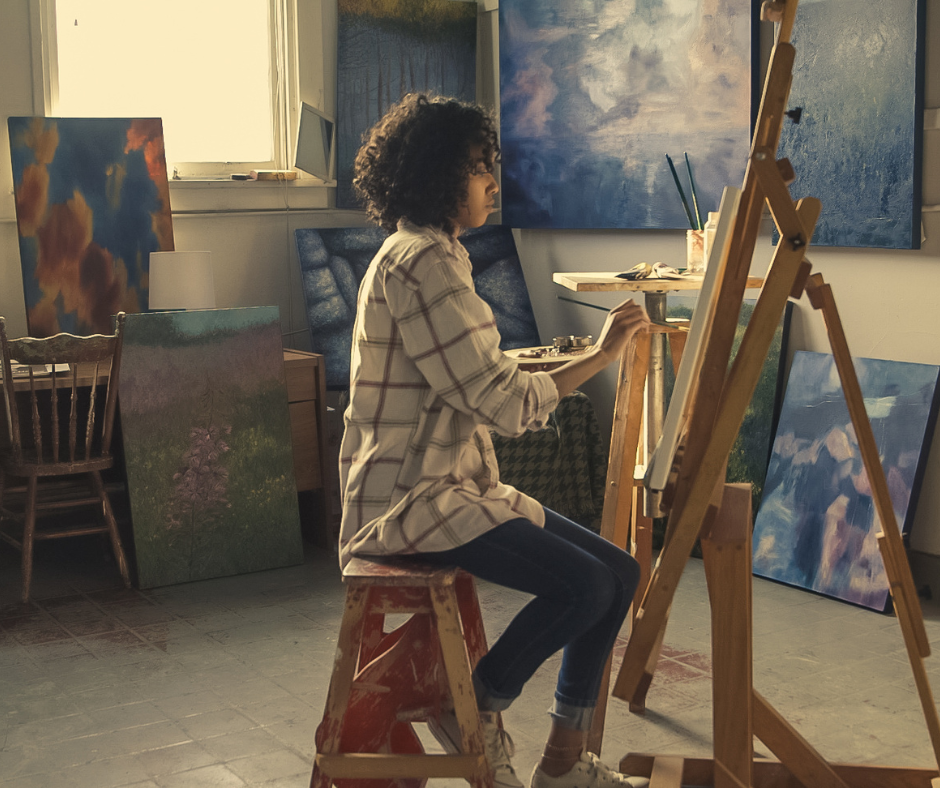
Side Hustles for Photographers and Other Artists
Summary
Reflection Questions
Journal Prompt
Whether a fine artist, graphic designer, or photographer, professionals in creative fields recognize the value of diversifying their income streams. The advent of digital platforms and the changing nature of the global market have opened new avenues for photographers and artists to augment their primary earnings. This article aims to explore a variety of side hustles that cater to the unique skill sets of these creatives, offering practical insights into opportunities beyond traditional roles. From selling prints and engaging in stock photography to conducting workshops and leveraging social media influence, let’s take a look at a few viable side hustles for creative entrepreneurs. These alternatives not only offer the chance to make a bit of extra money but also the chance to expand one’s brand reach, artistic skills, and professional network. Read on to learn more about side hustles for artists.
Side Hustles for Photographers and Fine Artists
Selling Prints and Merchandise

Our first photographer side hustle is creating and selling prints online. The sale of artwork and photographs as prints presents a lucrative opportunity for photographers and artists to monetize their creative endeavors. This practice involves reproducing original works in various formats and sizes, making art more accessible and affordable for a broader audience.
Print sales cater to a market that appreciates art and photography but may not have the means or inclination to purchase original works. The quality of reproductions, advancements in printing technology, and the variety of mediums available (such as canvas, archival paper, or metal) have made print selling an attractive and viable option for creatives looking to expand their income sources.
Licensing and providing a print-on-demand service can also be quite lucrative whether you operate a photography business or have a fine arts studio.
Platforms for Selling Merchandise Online
Several online platforms facilitate the sale of prints and art merchandise, each offering unique features and audiences. Etsy is renowned for its focus on handmade and vintage items, providing a space for artists to sell bespoke prints and custom merchandise. It attracts a clientele appreciative of individual craftsmanship and unique designs.
Redbubble and Society6, on the other hand, operate on a print-on-demand model. These platforms allow artists to upload their designs, which can then be printed on a wide range of products like apparel, phone cases, and home décor items. These sites handle production, shipping, and customer service, reducing the operational burden on the artist while providing a global platform to showcase their work.
Tips for Marketing and Product Diversification
Effective marketing and product diversification are key to success in selling prints and merchandise. Artists should leverage social media platforms to showcase their work and connect with potential buyers. Regularly updating portfolios, engaging with followers, and utilizing online advertising tools can increase visibility and sales.
Additionally, artists can diversify their product offerings by exploring different themes, styles, or product types to appeal to various customer preferences. Offering limited editions or signed prints can also add value and exclusivity, attracting collectors and art enthusiasts. Understanding market trends and customer feedback is crucial for adapting product lines and marketing strategies to suit changing consumer tastes and preferences.
Stock Photography

Whether wedding photography is your bread and butter or portrait photography is how you make money, producing stock photography can be a great side hustle. Stock photography offers a viable passive income stream for photographers. This sector involves selling photographs to stock photo agencies, which then license these images for use in various media, such as websites, magazines, and marketing materials.
The appeal of stock photos lies in their potential for recurring revenue; a single photograph can be sold multiple times to different clients. This model allows photographers to build a portfolio of work that continues to generate income over time, without the need for active, ongoing effort after the initial upload of the images.
Guidance on How to Sell Photos to Stock Photography Websites

To begin selling photos on stock photography websites, photographers first need to create a diverse and high-quality portfolio. Images should be well-composed, sharply focused, and high-resolution. Photographers then select a stock photo agency to work with, such as Shutterstock, Adobe Stock, or Getty Images.
Each platform has its own submission guidelines and acceptance criteria. Typically, photographers must submit their work for review; once accepted, the images become available on the platform for purchase. It’s important to understand the licensing terms and payment structures of each site, as these can vary and will affect the photographer’s earnings.
Strategies for Successful Stock Photos
Success in stock photography requires more than just technical skill; it also demands an understanding of market demand and trends. Successful stock photographers often research popular themes and subjects to guide their work. Subjects that are in high demand, yet underrepresented, are likely to yield better returns.
Additionally, photographers should consider seasonality in their submissions, providing relevant content for upcoming holidays and events. Another key strategy is to consistently update and diversify one’s portfolio to keep it fresh and appealing. Finally, understanding and utilizing keywords effectively ensures that images are discoverable by potential buyers searching the platform, thereby increasing the chances of sales.
Teaching Workshops or Classes

Hosting workshops, teaching classes, or choosing to create video tutorials presents a valuable opportunity for photographers and artists to share their knowledge and expertise while generating income beyond their typical full-time job. In-person workshops offer a direct and interactive way to teach specific skills, techniques, or concepts.
These can be conducted in various settings such as community centers, art studios, or educational institutions. The advent of digital technology has also opened up the realm of online teaching, allowing creatives to reach a broader, potentially global audience.
Online platforms facilitate various formats, from live webinars to pre-recorded online courses, providing flexibility for both instructors and students. Teaching not only allows you to earn money but also helps in building a professional network and enhancing one’s reputation in the field.
Discussing Platforms and Methods for Conducting Classes

For online teaching, there are several platforms that artists and photographers can use. Websites like Udemy, Skillshare, and Coursera allow professionals to create and sell an online course on their respective subjects.
These platforms handle many logistical aspects, such as course hosting and payment processing. For live classes or webinars, tools like Zoom, Google Meet, or Microsoft Teams are effective.
When conducting in-person workshops, the key is to find suitable venues that can cater to the needs of the class, such as adequate lighting for art workshops or quiet, spacious rooms for photography classes. Regardless of the mode of teaching, it is important to have a structured approach to course delivery, including clear objectives, comprehensive content, and engaging delivery methods.
Tips on Curriculum Development and Student Engagement

Developing an effective curriculum is crucial for the success of any educational program. This involves outlining clear learning objectives, structuring the course content logically, and including both theoretical and practical components.
For photographers and artists, this might involve a combination of lectures on principles and hands-on sessions for skill application. To enhance student engagement, interactive elements such as group discussions, live demonstrations, and feedback sessions can be incorporated.
Personalizing the learning experience, encouraging questions, and adapting teaching methods to suit different learning styles can significantly enhance student participation and learning outcomes. Moreover, providing resources for further learning and staying accessible for queries post-class can help in building lasting relationships with students.
Photo Editing and Retouching Services

As a creative person with her own business, you might also consider photo editing on the side. The market for photo editing and retouching services is vast and diverse, catering to a wide range of clients from individual photographers and hobbyists to professional studios, businesses, and advertising agencies.
This demand is driven by the need for high-quality, visually appealing images in various sectors including media, real estate, fashion, and e-commerce. With the proliferation of digital media, the emphasis on polished, professional-looking images has never been greater.
This market presents an opportunity for skilled photo editors and retouchers to offer their services, capitalizing on the need for image enhancement, restoration, and manipulation. It’s a great way to diversify your photography services without reaching too far into another field.
Skill Requirements and How to Offer These Services

To excel in photo editing and retouching, a comprehensive understanding of photo editing software, primarily Adobe Photoshop and Lightroom, is essential. Skills required include color correction, cropping, resizing, retouching, and the ability to work with layers and masks for more complex edits.
Advanced techniques, such as compositing, background removal, and portrait retouching, can also be beneficial. Offering these photo editing services begins with showcasing a portfolio that highlights one’s editing range and style.
Creating a website or using social media platforms to display before-and-after examples can effectively demonstrate skill levels to potential clients. Freelancers can also list their services on platforms like Fiverr, Upwork, or Freelancer to reach a wider audience.
Building a Client Base for Editing Work
Developing a robust client base requires a combination of marketing strategies and networking. Word-of-mouth referrals play a significant role and can be fostered by consistently delivering high-quality work and maintaining good relationships with clients.
Networking with photographers, attending industry events, and engaging with online photography communities can also lead to new client opportunities. Additionally, leveraging social media for marketing, engaging with potential clients, and showcasing work can attract a broader clientele.
Offering competitive pricing, package deals, or a quick turnaround time can further entice customers. As the client base grows, maintaining a high standard of work, meeting deadlines, and clear communication will ensure client retention and ongoing referrals.
Art Commissions

Accepting art commissions involves creating custom artwork for clients, tailored to their specific requirements and preferences. This process presents a significant opportunity for artists to diversify their income and work on varied and often challenging projects.
The potential in art commissions lies in their personalized nature; clients are willing to pay a premium for artwork that is unique and meaningful to them. The commissioning process typically begins with a consultation to understand the client’s vision, followed by discussions about size, medium, style, and subject matter.
Artists must then translate these requirements into a finished piece, often requiring several iterations and ongoing communication with the client. Successfully managing commissions and creating art specifically for each client not only adds a revenue stream but also helps in developing a versatile portfolio and honing art skills.
Without accepting commissions, you might never have branched out into certain styles, media, or subjects.
Setting Terms and Conditions for Commissions
Setting clear terms and conditions is crucial for a smooth commissioning process. This includes outlining the scope of work, pricing, timelines, payment terms, and any revision policies. Artists should provide a contract or agreement detailing these terms to avoid misunderstandings and ensure both parties are clear about expectations.
It’s important to include details about the rights to the artwork, especially concerning reproduction and usage. Pricing can be complex and should consider factors such as the size of the artwork, the complexity of the project, materials used, and the estimated time required. A deposit or partial payment upfront is common practice to secure the commission and cover initial expenses.
Marketing and Building a Reputation for Commissioned Work
Marketing commissioned work effectively requires showcasing one’s range and versatility as an artist. This can be done through a well-maintained portfolio, either online or in print, featuring a selection of previous commissions.
Social media platforms, artist websites, and online galleries are essential tools for reaching potential clients. Networking in art circles, participating in exhibitions, and engaging with local art communities can also lead to commission opportunities.
Building a reputation requires not just artistic talent but also professionalism in handling client relationships, meeting deadlines, and delivering quality work consistently. Satisfied clients often become repeat customers and can provide valuable word-of-mouth referrals, which are instrumental in growing an artist’s client base for commissions.
Photography Tours and Travel Workshops

Photography tours and travel workshops combine the passion for photography with the love of travel, providing unique experiences for both amateur and professional photographers. These tours are typically organized in visually stunning or culturally rich locations, offering participants the chance to learn and practice photography in diverse settings. Workshops often include hands-on training from experienced photographers, covering various aspects of photography such as technique, composition, lighting, and post-processing. These tours not only enhance photographic skills but also provide immersive cultural experiences, as participants explore and capture different landscapes, cityscapes, and lifestyles.
Logistics, Planning, and Marketing of Travel Workshops
The logistics and planning of photography tours and workshops require meticulous attention to detail. Organizers must consider factors such as location scouting, timing (including the best time of day for photography in each location), accommodation, transportation, and local permissions or regulations.
It is also essential to plan for different skill levels and interests, ensuring that the itinerary is engaging and beneficial for all participants. Marketing these workshops effectively involves showcasing the unique features and potential learning outcomes of the tour.
Utilizing social media, photography forums, and partnerships with travel agencies can help reach the target audience. Additionally, offering early bird discounts, package deals, or exclusive sessions can attract potential participants.
Clear communication regarding the itinerary, costs, equipment needed, and physical demands of the tour is essential to manage expectations and ensure participant satisfaction.
Sharing Personal Experiences or Case Studies
Incorporating personal experiences or case studies into the promotion and execution of photography tours adds authenticity and can be a powerful marketing tool. Sharing anecdotes, photographic outcomes, or testimonials from previous tours helps potential participants envision the experience and the learning opportunities.
Case studies highlighting how past participants have improved their skills or achieved specific photography goals can be particularly compelling. Personal stories from the organizer about the destinations, their significance, and photographic potential can also ignite interest and enthusiasm.
These narratives provide a glimpse into the experience beyond the technical aspects of photography, emphasizing the adventure, cultural immersion, and personal growth opportunities inherent in these tours.
Writing and Blogging

For photographers and artists, blogging and writing present substantial opportunities to share their expertise, showcase their work, and connect with a wider audience. Creating a blog allows them to delve deeper into various aspects of their craft, be it through sharing techniques, reviewing equipment, providing insights into the creative process, or discussing industry trends.
Writing can also extend beyond personal blogs to contributing articles or tutorials to an established photography or art blog. These platforms not only help in building a professional profile but also in reaching an audience interested in art and photography, thus expanding their influence in the field.
Monetization Strategies: Sponsored Content, Affiliate Marketing
Monetization of a blog or writing endeavors can be achieved through various strategies. One effective approach is sponsored content, where companies pay to feature their products or services on the blog.
This can include gear reviews, sponsored posts about certain techniques or products, or even featuring specific brands in the creative workflow. Another lucrative strategy is affiliate marketing, where the blogger earns a commission for products sold through links provided in their blog.
This is particularly effective when recommending photography equipment, art supplies, or software tools. For these strategies to be successful, it is crucial to maintain authenticity and transparency with the audience.
Building a Following and Leveraging it for Income
The key to successful monetization through blogging and writing is building and maintaining a dedicated following. Engaging content that provides value to the audience is essential in attracting and retaining readers.
Regular updates, interactive elements like comments or forums, and leveraging social media for promotion can help in growing the audience. Networking with other bloggers and participating in online communities can also expand reach.
Once a substantial following is established, it can be leveraged for income through strategies like exclusive content for subscribers, paid memberships for detailed tutorials or courses, or selling e-books and guides. Building a following requires time and consistent effort, but it establishes a foundation for sustainable income through blogging and writing.
Renting Out Studio Space

For photographers and artists who own or lease studio space, renting it out can be a lucrative side hustle. This option is particularly viable in areas where studio space is in high demand, such as in urban centers or communities with a thriving arts scene.
Renting out studio space can cater to fellow photographers and artists who don’t have a permanent space, as well as to individuals or groups needing a space for various events like workshops, classes, or small gatherings. The demand for unique and well-equipped spaces for photoshoots, especially in the era of social media and online marketing, further broadens the potential market for studio rentals.
Managing Bookings and Pricing
Effective management of bookings and pricing is crucial for the successful rental of studio space. Setting up an online booking system can streamline the process and make it more efficient for both the owner and the clients. Pricing should be competitive yet reflective of the facilities and equipment offered.
It’s advisable to research local market rates to ensure pricing is in line with similar offerings. Offering flexible rental packages, such as hourly, half-day, or full-day rates, can cater to a wider range of needs and budgets. Clear communication regarding availability, booking procedures, and cancellation policies is essential to avoid conflicts and ensure smooth operations.
Legal Considerations and Insurance
Renting out studio space also involves legal considerations and insurance. It’s important to have a written rental agreement that outlines the terms and conditions of the rental, including the responsibilities of both parties, usage rules, and liability in case of damages or accidents.
Obtaining adequate insurance is crucial to protect against potential liabilities. This may include property insurance, liability insurance, and, depending on the location and nature of the studio, additional coverage for equipment and artworks.
Ensuring compliance with local zoning laws and building codes is also important to avoid legal complications. Consulting with a legal expert to draft the rental agreement and understand the necessary insurance and legal requirements is recommended for studio owners considering this side hustle.
Final Thoughts

From selling prints and teaching workshops to creating online content, these opportunities not only supplement income but also enrich professional and creative experiences. Artists and photographers are encouraged to explore and experiment with these various streams, finding those that align best with their skills and passions. Ultimately, the key to success in these endeavors lies in balancing creativity with business acumen, ensuring that artistic integrity and commercial viability coexist harmoniously. By embracing these side hustles, creative professionals can broaden their horizons, secure financial stability, and continue to thrive in their artistic pursuits.








